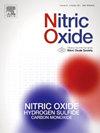Real-time nitric oxide detection in cytokine stimulated cancer cells and macrophages
IF 3.2
2区 生物学
Q2 BIOCHEMISTRY & MOLECULAR BIOLOGY
引用次数: 0
Abstract
Inflammation is increasingly linked to disease progression, particularly in cancer, where elevated levels of inducible nitric oxide synthase (iNOS or NOS2), driven by tumor inflammation, is correlated with aggressive tumors and poor outcomes. Measuring nitric oxide levels in tumor cells is hampered by the reactive nature of the molecule and generally inferred through indirect measurement of reaction products such as nitrate and nitrite. Here, we adapt the oxyhemoglobin detection method to tissue culture and examine nitric oxide production in tumor cells in response to inflammatory cytokines. Our assay provides real-time nitric oxide measurement, is highly sensitive, linear for at least an hour, inexpensive, and easy to implement. We show that triple negative breast and colorectal cancer cells respond to interferon gamma (IFNγ), interleukin 1-β (IL1-β) and tumor necrosis factor α (TNFα) to generate surprisingly high levels of NOS2 protein and nitric oxide, as high as seen in activated macrophages for fighting infection. NO detection levels reach 1.3 pmol NO/min/μg total cellular protein. The assay is readily adapted to assessing IC50 values for NOS2 inhibition, inhibition rates, and inhibition persistence. Using triple negative breast cancer cell line 4T1, a syngeneic murine tumor model, we estimate an IC50 = 3.4 μM for NOS2-specific inhibitor 1400W, which displays a low nanomolar binding constant to isolated protein. Inhibition is rapid (<10 min) and persists for at least an hour. These results highlight the importance of nitric oxide production in the tumor and provide a means for developing new therapeutic strategies.

细胞因子刺激的癌细胞和巨噬细胞中一氧化氮的实时检测。
炎症与疾病进展的关系越来越密切,尤其是在癌症中,肿瘤炎症导致的诱导型一氧化氮合酶(iNOS 或 NOS2)水平升高与侵袭性肿瘤和不良预后有关。由于一氧化氮分子具有反应性,因此测量肿瘤细胞中的一氧化氮水平受到阻碍,通常只能通过间接测量硝酸盐和亚硝酸盐等反应产物来推断。在这里,我们将氧合血红蛋白检测方法应用于组织培养,并检测肿瘤细胞在炎症细胞因子作用下产生的一氧化氮。我们的检测方法可实时测量一氧化氮,灵敏度高,线性时间至少一小时,成本低廉,易于实施。我们的研究表明,三阴性乳腺癌和结肠直肠癌细胞对γ干扰素(IFNγ)、白细胞介素1-β(IL1-β)和肿瘤坏死因子α(TNFα)产生反应,生成高水平的NOS2蛋白和一氧化氮,与活化的巨噬细胞抗感染时的水平相当。一氧化氮的检测水平达到 1.3 pmol NO/min/μg 细胞总蛋白。该检测方法可用于评估 NOS2 抑制作用的 IC50 值、抑制率和抑制持续性。利用三阴性乳腺癌细胞系 4T1(一种合成鼠肿瘤模型),我们估计 NOS2 特异性抑制剂 1400W 的 IC50 值为 3.4 μM,它与分离蛋白的结合常数很低,仅为纳摩尔。抑制作用迅速 (
本文章由计算机程序翻译,如有差异,请以英文原文为准。
求助全文
约1分钟内获得全文
求助全文
来源期刊

Nitric oxide : biology and chemistry
生物-生化与分子生物学
CiteScore
7.50
自引率
7.70%
发文量
74
审稿时长
52 days
期刊介绍:
Nitric Oxide includes original research, methodology papers and reviews relating to nitric oxide and other gasotransmitters such as hydrogen sulfide and carbon monoxide. Special emphasis is placed on the biological chemistry, physiology, pharmacology, enzymology and pathological significance of these molecules in human health and disease. The journal also accepts manuscripts relating to plant and microbial studies involving these molecules.
 求助内容:
求助内容: 应助结果提醒方式:
应助结果提醒方式:


